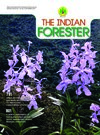Enumeration of the Family Nyctaginaceae in India
DOI:
https://doi.org/10.36808/if/2018/v144i9/116374Keywords:
Nyctaginaceae, Taxonomic Enumeration, India.Abstract
The present article comprises the enumeration of the taxa belonging to the family Nyctaginaceae in India. In this paper, currently accepted name, basionym (if any), important synonyms, local names, phenology, distribution and ecology, uses and notes have been provided for each taxon.References
Anon. (1962).The Wealth of India-Raw Materials VI: 392–393. Council of Scientific and Industrial Research, New Delhi.
Backer C.A. and Bakhuizen V.D.B.R.C. (1963). Flora of Java (Spermatophytes only).1: 269-272 (Nyctaginaceae). N.V.P. Noordhoff-Groningen. The Netherlands.
Bamber C.J. (1916). Plants of the Punjab: A Descriptive Key to the Flora of the Punjab, North-West Frontier Province and Kashmir. Superintendent Government Printing,Lahore, Punjab.
Bentham G. and Hooker J.D. (1880).Genera Plantarum.Williams & Norgate, London.
Bentham G. (1870). Flora Australiensis Vol. V Novell Reeve & Co., London, 279-281 pp.
Bhatt R.P. and Sabnis S.D. (1987). Contribution to the ethnobotany of Khedbrahma region of north Gujarat. J. Econ. Taxon. Bot., 9(1): 139-145.
Boissier E. (1879). Flora Orientalis4: 1043-1046 (Nyctaginaceae).Genevaeet Basileae, Lugduni.
Choisy J.D. (1849). Nyctaginaceae. In de Candolle, Prodromus Regni Vegetabilis Paris.
Chopra R.N., Nayar S.L. and Chopra I.C. (1956). Glossary of Indian Medicinal Plants. CSIR, New Delhi. 39pp.
Chrtek J. and Krisa B. (1976).Nyctaginaceae. In Fl. Iranica (Rechinger, K.H. (ed.), 115: 3. Graz-Austria :AkademischeSruck-u., Verlagsanstalt.
Cooke T. (1958).Flora of the Presidency of Bombay. Botanical Survey of India, Calcutta (Repr. ed.).
Dalzell N.A. and Gibson A. (1861).The Bombay Flora or Short Descriptions of All the Indigenous Plants Hitherto Discovered in or near the Bombay Presidency. Education Society’s Press, Bombay.
Dequan L. and Gilbert M.G. (2003).Nyctaginaceae. In Fl. China (Zhengyi, et al. (eds.),5: 430-434. Missouri Botanical Garden Press (St. Louis).
Douglas N. and Spellenberg R. (2010). A new tribal classification of Nyctaginaceae. Taxon., 59(3): 905-910.
Edgeworth M.P. (1846). Plants from North-Western India. Transactions of the Linnean Society of London, 20: 87.
Gamble J.S. (1956). Flora of the Presidency of Madras. 2(2):813815 (Nyctaginaceae). Botanical Survey of India, Calcutta (Repr. ed.).
Govett R.H. (1884). A bird-killing tree.Trans. & Proc. New Zealand Inst., 16: 364-366.
Grahams J. (1839).A Catalogue of the Plants Growing in Bombay and its Vicinity. Bombay Govt. Press., Bombay.
Grierson A.J.C. and Long D.G. (1984).Nyctaginaceae. In: Flora of Bhutan (Grierson & Long (eds.). 1(2): 191-194. Royal Botanic Garden, Edinburgh.
Guha-Bakshi D.N., Sen Sarma P. and Pal D.C. (1999). A lexicon of medicinal plants in India. Naya Prakash, Calcutta, 1(2): 94, 297.
Heimerl A. (1934). Nyctaginaceae. In: Engler, A. and Prantl K. (Die) Naturlichen Pflanzenfamilien.ed.2. Vol. 16c. Berlin. pp. 86-134.
Hooker J.D. (1885).Nyctagineae. In: Hooker, J.D. The Flora of British India. Vol. 4. L. Reeve & Co., London. pp. 708-711.
Horaninov P.F. (1847).Characteres essentials familiarum ac tribuumregnivegetabiliset amphorganici. Petropoli, Wienhoberianis.
Hutchinson J. (1967).The Genera of Flowering Plants (Angiospermae).Dicotyledones. Vol. II. Clarendon Press, Oxford.
Ikeda T., Y. Takanami S., Imaizumi T., Matsumoto Y. Mikami and Kubo S. (1987). Formation of anti-plant viral protein by Mirabilis jalapa L. cells in suspension-culture. Plant Cell reports, 6(3): 216218.
John St. H. (1951). The distribution of Pisoniagrandis (Nyctaginaceae): Pacific Plant Studies No. 10., Webbia, 8(1): 225-228.
Jussieu A.L.de. (1789).Genera Plantarum: Secundum ordines naturalesdisposita, juxta methodum in Horto region parisiensiexaratum, vol.1774. Apudviduam Herissant Parisiis et Thiophilum Barrois, Parisiis.
Kirk T. (1884). Botanical notes. Trans. Proc. New Zealand Inst., 16: 367-168.
Kirtikar K.R. and Basu B.D. (1918).Indian Medicinal Plants 3: 2049 (Nyctaginaceae). Allahabad, India. (Repr. ed.).
Kurz S. (1877). Forest Flora of British Burma.2: 279 (Nyctaginaceae). The Superintendent Government Printing, Calcutta.
Mabberley D.J. (2008).The Plant-Book: A Portable Dictionary of the VascularPlants. Cambridge University Press.(ed. 3).
Maiti G.G. and Hore D.K. (1976). A note on the occurrence and distribution of Boerhavia erecta L. India. Bull. Bot. Soc. Bengal, 32: 36-40.
Melchior H. (1964). Engler’s syllabus der Pflanzenfamilien. Gerbruder Borntraeger Berlin.
Mukherjee A.K. (1984). Revision of the Family Nyctaginaceae in India, J. Econ. Taxon. Bot., 5(3):581-590.
Mukherjee S.K. (1973). Materials for the Flora of Bhutan. Rec. Bot. Surv. India, 20(2): 173.
Nair N.C. and Nair V.J. (1964). Boerhavia punarnava Saha et Krishnam.: A new record for Kerala State. J. Bombay Nat. Hist. Soc., 61(1): 216-217.
Nasir Y.J. (1977). Nyctaginaceae in Nasir E. and Ali S.I. (eds.), Flora of West Pakistan National Herbarium, Agricultural Research Council, Islamabad. 115: 1-16.
Parkinson C.E. (1923).A Forest Flora of the Andaman Islands. Superintendent, Government Central Press, Shimla. 221-223 pp.
Ramarethinam S. (1964). Boerhavia punarnava Saha & Krishnam : A new record for Maharashtra. J. Bombay Nat. Hist. Soc., 61(1): 217-218.
Rao R.S. and Hemadri K. (1970).Boerhavia punarnava saha et Krish., Sci. & Cult., 36 (4): 218.
Rastogi R.P. and Mehrotra B.N. (1993). Compendium Indian Medicinal Plants. Central Drug Research Institute, Lucknow, Publication & Information Directorate, New Delhi, 3: 429.
Ridley H.N. (1924). The Flora of the Malay Peninsula (Nyctagineae). L. Reeve & Co., Ltd., London. 3: 1-3.
Roxburgh W. (1820).Flora Indica. Vol. 1.Mission Press. Serampore. 148 pp.
Saha J.C. and Krishnamurthy K.H. (1962).Boerhavia punarnava Saha & Krishnam., J. Sci. Ind. Res., 21C(9): 244-255.
Singh V. and Singh M. (2006).Biodiversity of Desert National Park, Rajasthan. (Nyctaginaceae).Botanical Survey of India, Kolkata. 139-142 pp.
Standley P.C. (1918). Allioniaceae. In: North Amer. Fl., 21: 171254.
Stemmerik J.F. (1964). Nyctaginaceae In van Steenis, C.G.J. (ed.), Flora Malesiana. Ser., 1, 6: 450-468. Wolters-Noordhoff Publishing, Groningen, The Netherlands.
Stewart J.L. (1920).Punjab Plants, Comprising Botanical and Vernacular Names and Uses of most the Trees, Shrubs, and Herbs of Economical value, growing within the Province. Government Press, Public Works Department. Lahore. 182 pp.
Takhtajan A.L. (1997).Diversity and Classification of Flowering Plants. Columbia University Press, New York.
Vajravelu E. and Daniel P. (1983). In: Materials for a Catalogue of Threatened Plants of India (Jain, S.K. and Sastry A.R.K. (Eds.), Botanical Survey of India, Howrah.
White C.T. (1924). An insect-catching tree, Austral. For. J., 7: 36.
Downloads
Downloads
Published
How to Cite
Issue
Section
License
Unless otherwise stated, copyright or similar rights in all materials presented on the site, including graphical images, are owned by Indian Forester.





